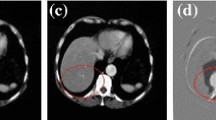Abstract
Purpose
We introduce a new hierarchical approach for elastic medical image registration using approximating splines. In order to obtain the dense deformation field, we employ Gaussian elastic body splines (GEBS) that incorporate anisotropic landmark errors and rotation information. Since the GEBS approach is based on a physical model in form of analytical solutions of the Navier equation, it can very well cope with the local as well as global deformations present in the images by varying the standard deviation of the Gaussian forces.
Methods
The proposed GEBS approximating model is integrated into the elastic hierarchical image registration framework, which decomposes a nonrigid registration problem into numerous local rigid transformations. The approximating GEBS registration scheme incorporates anisotropic landmark errors as well as rotation information. The anisotropic landmark localization uncertainties can be estimated directly from the image data, and in this case, they represent the minimal stochastic localization error, i.e., the Cramér-Rao bound. The rotation information of each landmark obtained from the hierarchical procedure is transposed in an additional angular landmark, doubling the number of landmarks in the GEBS model.
Results
The modified hierarchical registration using the approximating GEBS model is applied to register 161 image pairs from a digital mammogram database. The obtained results are very encouraging, and the proposed approach significantly improved all registrations comparing the mean-square error in relation to approximating TPS with the rotation information. On artificially deformed breast images, the newly proposed method performed better than the state-of-the-art registration algorithm introduced by Rueckert et al. (IEEE Trans Med Imaging 18:712–721, 1999). The average error per breast tissue pixel was less than 2.23 pixels compared to 2.46 pixels for Rueckert’s method.
Conclusion
The proposed hierarchical elastic image registration approach incorporates the GEBS approximation scheme extended with anisotropic landmark localization uncertainties as well as rotation information. Our experimental results show that the proposed scheme improved the registration result significantly.



Similar content being viewed by others
References
Maintz JBA, Viergever MA (1998) A survey of medical image registration. Med Im Anal 2(1):1–36
Modersitzki J (2004) Numerical methods for image registration. Oxford University Press, Oxford
Crum WR, Hartkens T, Hill DLG (2004) Non-rigid image registration: theory and practice. British J Radiol 77(special issue):S140–S153
Hill DLG, Bathcelor PG, Holden M, Hawkes DJ (2001) Medical image registration. Phys Med Biol 46:1–44
Zitova B, Flusser J (2003) Image registration methods: a survey. Image Vis Comput 21(11):977–1000
Bookstein FL (1989) Principal warps: thin-plate splines decomposition of deformation. IEEE Trans Pattern Anal Mach Intell 11:567–585
Rueckert D, Sonoda LI, Hayes C, Hill DLG, Leach MO, Hawkes DJ (1999) Nonrigid registration using free-form deformations: application to breast MR images. IEEE Trans Med Imaging 18:712–721
Davis M, Khotanzad A, Flaming D, Harms S (1997) A physics-based coordinate transformation for 3D image matching. IEEE Trans Med Imaging 16(3):317–328
Kohlrausch J, Rohr K, Stiehl H (2001) A new class of elastic body splines for nonrigid registration of medical images. In: Handels H, Horsch A, Lehmann T, Meinzer H-P (eds) Proceedings of the workshop Bildverarbeitung für die Medizin (BVM’01). Informatik aktuell 36. Springer, Berlin/Heidelberg, pp 164–168
Rohr K, Sprengel R, Stiehl HS (1997) Incorporation of landmark error ellipsoids for image registration based on approximating thin-plate splines. In: Proceedings of the computer assisted radiology and surgery (CAR ’97), pp 234–239
Rohr K (1998) Image registration based on thin-plate splines and local estimates of anisotropic landmark localization uncertainties. In: Proceedings of the first international conference on medical image computing and computer-assisted intervention (MICCAI ’98), pp 1174–1183
Wörz S, Rohr K (2006) New approximating Gaussian elastic body splines for landmark-based registration of medical images. Bildverarbeitung für die Medizin, pp 206–210
Bookstein FL, Green DK (1993) A feature space for edgels in images with landmarks. J Math Imaging Vision 3:231–261
Lewis J, Hwang HJ, Neumann U, Enciso R (2004) Smart point landmark distribution for thin-plate splines. In: Proceeding of SPIE medical imaging, pp. 1236–1243
Mardia KV, Kent JT (1996) Kriging and splines with derivative information. Biometrika 83:207–221
Rohr K, Fornefett M, Stiehl HS (2003) Spline-based elastic image registration: integration of landmark errors and orientation attributes. Comput Vis Image Underst 90:153–168
Serifovic-Trbalic A, Demirovic D, Prljaca N, Szekely G, Cattin P (2009) Intensity based elastic registration incorporating anisotropic landmark errors and rotational information. Int J Comput Assist Radiol Surg (JCARS) 4(5):463–468
Andronache A, Cattin P, Szekely G (2005) Adaptive subdivision for hierarchical non-rigid registration of multi-modal images using mutual information. Med Image Comput Comput Assist Interv 90:976–983
Chen Y, Dass S, Ross A, Jain A (2005) Fingerprint deformation models using minutiae locations and orientations. Appl Comput Vis IEEE Workshop Motion Video Comput 1:150–155
Chou P, Pagano N (1992) Elasticity—tensor, dyadic, and engineering approaches. Dover, New York
Gefen A, Dilmoney B (2007) Mechanics of the normal woman’s breast. J Technol Health Care 15(4):259–271
Lowe DG (2004) Distinctive image features from scale-invariant keypoints. Int J Comput Vis 60(2):91–110
Author information
Authors and Affiliations
Corresponding author
Additional information
This work has been supported by the SCOPES program of the Swiss National Science Foundation (http://www.snf.ch).
Rights and permissions
About this article
Cite this article
Serifovic-Trbalic, A., Demirovic, D. & Cattin, P.C. Intensity-based hierarchical elastic registration using approximating splines. Int J CARS 9, 21–27 (2014). https://doi.org/10.1007/s11548-013-0906-7
Received:
Accepted:
Published:
Issue Date:
DOI: https://doi.org/10.1007/s11548-013-0906-7




